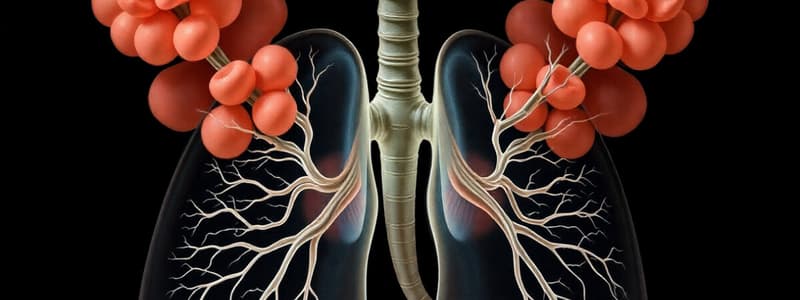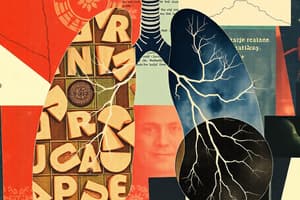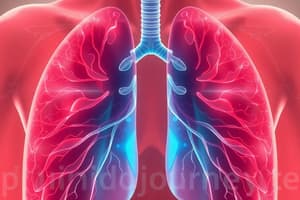Podcast
Questions and Answers
Which of the following scenarios best illustrates the interplay between the sympathetic and parasympathetic nervous systems?
Which of the following scenarios best illustrates the interplay between the sympathetic and parasympathetic nervous systems?
- During a calm yoga session, heart rate decreases and digestion is stimulated. (correct)
- While reading a book, visual information is processed by the occipital lobe.
- In response to a loud noise, the body initiates the sensation of pain.
- While lifting weights, skeletal muscles contract under voluntary control.
Damage to the myelin sheath of a neuron would most likely result in which of the following?
Damage to the myelin sheath of a neuron would most likely result in which of the following?
- Slower or disrupted transmission of electrical signals. (correct)
- Inability of the neuron to receive signals from other neurons.
- Increased speed of signal transmission along the axon.
- Uncontrolled release of neurotransmitters into the synaptic gap.
During a knee-jerk reflex, what is the correct sequence of information flow?
During a knee-jerk reflex, what is the correct sequence of information flow?
- Sensory neuron → motor neuron → interneuron → muscle contraction.
- Sensory neuron → interneuron → motor neuron → muscle contraction. (correct)
- Motor neuron → sensory neuron → interneuron → muscle contraction.
- Interneuron → sensory neuron → motor neuron → muscle contraction.
If a person sustains damage to their temporal lobe, which of the following functions would most likely be impaired?
If a person sustains damage to their temporal lobe, which of the following functions would most likely be impaired?
What is the primary role of neurotransmitters in synaptic transmission?
What is the primary role of neurotransmitters in synaptic transmission?
During intense exercise, the body may switch to anaerobic respiration. What is the primary consequence of this shift in metabolism?
During intense exercise, the body may switch to anaerobic respiration. What is the primary consequence of this shift in metabolism?
How does the body respond to the increased oxygen demand during physical exercise, coordinating both the respiratory and circulatory systems?
How does the body respond to the increased oxygen demand during physical exercise, coordinating both the respiratory and circulatory systems?
In an experiment testing for the presence of carbon dioxide in exhaled air, what observable change would indicate a positive result, confirming the presence of CO₂?
In an experiment testing for the presence of carbon dioxide in exhaled air, what observable change would indicate a positive result, confirming the presence of CO₂?
What is the primary role of hemoglobin in the context of oxygen transport from the lungs to the body's cells?
What is the primary role of hemoglobin in the context of oxygen transport from the lungs to the body's cells?
Why is the structure of the alveoli, with their numerous tiny air sacs surrounded by capillaries, essential for efficient gas exchange?
Why is the structure of the alveoli, with their numerous tiny air sacs surrounded by capillaries, essential for efficient gas exchange?
What distinguishes the roles of the central nervous system (CNS) and the peripheral nervous system (PNS)?
What distinguishes the roles of the central nervous system (CNS) and the peripheral nervous system (PNS)?
Following a head trauma, a patient exhibits impaired balance and coordination. Which part of the hindbrain is most likely affected?
Following a head trauma, a patient exhibits impaired balance and coordination. Which part of the hindbrain is most likely affected?
After damage to a specific area of the brain, a person struggles with regulating body temperature and maintaining stable hormone levels. Which area is most likely affected?
After damage to a specific area of the brain, a person struggles with regulating body temperature and maintaining stable hormone levels. Which area is most likely affected?
Flashcards
What is the CNS?
What is the CNS?
Part of the nervous system that includes the brain and spinal cord
What is the PNS?
What is the PNS?
Part of the nervous system that sends signals between the CNS and the rest of the body
What are functions of the Frontal Lobe?
What are functions of the Frontal Lobe?
Thinking, decision-making, voluntary movement
What is a reflex arc?
What is a reflex arc?
Signup and view all the flashcards
What do Motor Neurons do?
What do Motor Neurons do?
Signup and view all the flashcards
Nose Function
Nose Function
Signup and view all the flashcards
Alveoli
Alveoli
Signup and view all the flashcards
Spirometer
Spirometer
Signup and view all the flashcards
Aerobic Respiration Equation
Aerobic Respiration Equation
Signup and view all the flashcards
Anaerobic Respiration Equation
Anaerobic Respiration Equation
Signup and view all the flashcards
Central Nervous System (CNS)
Central Nervous System (CNS)
Signup and view all the flashcards
Cerebrum Function
Cerebrum Function
Signup and view all the flashcards
Cerebellum Function
Cerebellum Function
Signup and view all the flashcards
Study Notes
- The respiratory system facilitates oxygen intake from the atmosphere to the lungs
- The nervous system controls the body's functions through a complex network
Pathway of Oxygen
- Oxygen follows a specific route: nose, pharynx, larynx, trachea, bronchi, bronchioles, and alveoli
Alveoli Function
- Alveoli enable gas exchange, with oxygen entering the blood and carbon dioxide exiting
Exercise effects
- Exercise boosts breathing and heart rate to meet increased oxygen demands and eliminate carbon dioxide
Lung Capacity Measurement
- Spirometers assesses lung volumes like tidal volume and vital capacity to gauge respiratory health
Oxygen Transport
- Oxygen is transported via hemoglobin in red blood cells from the lungs to cells, while carbon dioxide returns for exhalation
Aerobic Respiration
- Aerobic respiration converts glucose and oxygen into carbon dioxide, water, and ATP energy: C₆H₁₂O₆ + 6O₂ → 6CO₂ + 6H₂O + ATP
CO₂ Detection
- Exhaled air contains CO₂, as evidenced by limewater turning milky when exposed to breath
Anaerobic Respiration
- Anaerobic respiration produces energy and lactic acid in the absence of oxygen: Glucose → Lactic Acid + Energy
Nervous System Divisions
- The nervous system is split into the central nervous system (CNS) and peripheral nervous system (PNS)
Brain Components
- The forebrain manages high-level functions, the midbrain relays signals, and the hindbrain oversees vital functions
CNS vs PNS
- The CNS consists of the brain and spinal cord, processing information, while the PNS comprises nerves that send signals between the CNS and body
Brain Lobes
- The frontal lobe handles thinking, the parietal lobe processes sensory input, the occipital lobe manages vision, and the temporal lobe governs hearing and memory
Autonomic vs Somatic
- The autonomic nervous system regulates involuntary functions, while the somatic nervous system controls voluntary movements
Sympathetic vs Parasympathetic
- The sympathetic nervous system triggers "fight or flight" responses, while the parasympathetic system promotes "rest and digest" activities
Neuron types
- Motor neurons transmit signals from the CNS to muscles, sensory neurons carry signals to the CNS, and relay neurons connect the sensory and motor neurons
Neuron parts
- A neuron includes:
- An axon that sends impulses
- A myelin sheath that insulates and speeds up signals
- A cell body that processes signals
- Nodes of Ranvier that assist transmission
- Dendrites that receive signals
Reflex Arc
- The reflex arc is an automatic response pathway: stimulus → sensory neuron → interneuron → motor neuron → muscle contraction
Synaptic Transmission
- During synaptic transmission, neurotransmitters are released to carry impulses across neurons
Studying That Suits You
Use AI to generate personalized quizzes and flashcards to suit your learning preferences.




